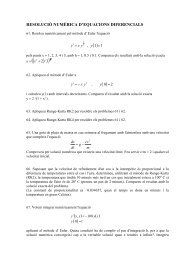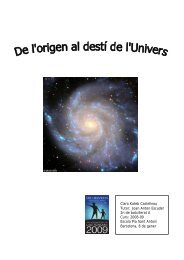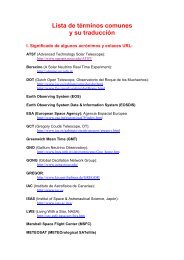Universitat de - Departament d'Astronomia i Meteorologia ...
Universitat de - Departament d'Astronomia i Meteorologia ...
Universitat de - Departament d'Astronomia i Meteorologia ...
You also want an ePaper? Increase the reach of your titles
YUMPU automatically turns print PDFs into web optimized ePapers that Google loves.
106 Chapter 3. LS 5039 as a runaway microquasar<br />
3.5 The H i surroundings of LS 5039<br />
Notwithstanding the absence of structures that can be clearly associated with the<br />
SNR in the H i distribution, the channel maps in the interval 10–46 km s −1 (see<br />
Fig. 3.5) reveal the existence of a large, semi-open cavity which is very similar to<br />
bubbles blown out by early-type stars in regions with steep <strong>de</strong>nsity gradients (e.g.,<br />
Benaglia & Cappa 1999). This phenomenon has also been observed around another<br />
HMXB (HD 153919) by Benaglia & Cappa (1999). The ambient material is thought<br />
to be swept up by the strong wind of the massive early-type star in the binary system<br />
creating a local minimum around the star. Density gradients towards the galactic<br />
plane in the original matter distribution can result in a preferred escape direction for<br />
the wind, yielding open structures. Even in some cases the star appears displaced<br />
from the actual minimum in the H i distribution.<br />
The bubble <strong>de</strong>tected around LS 5039 is centered at a systemic velocity of vsys <br />
33 km s −1 , with an expansion velocity vexp 12 km s −1 . The galactic rotation mo<strong>de</strong>l<br />
by Fich et al. (1989) indicates that it is located at a distance of 3.2 kpc, quite<br />
consistent with the distance to the microquasar. The total mass removed in or<strong>de</strong>r<br />
to create the cavity is ∼ 1.5 × 10 4 M⊙, implying a kinetic energy ∼ 2 × 10 49 erg s −1 ,<br />
which can be consi<strong>de</strong>red as a rough estimate of the energy <strong>de</strong>posited by the wind<br />
of the star into the ISM. Such a value is in accordance with previous estimates for<br />
similar Of star wind blown bubbles (e.g., Benaglia & Cappa 1999). With a radius of<br />
∼ 60 pc, the dynamical age of the bubble is ∼ 3×10 6 yr, which should be consi<strong>de</strong>red<br />
as an upper limit for its actual age since it ignores possible contributions from the<br />
SN explosion and the wind of the progenitor of the compact star.<br />
We have also searched for other contributors to the cavity, among stars earlier<br />
than B2 that were projected over the cavity, and whose distances were in agree-<br />
ment with that of LS 5039. It seems unlikely that the Wolf Rayet star WR 115<br />
(WN6+OB?) could contribute in some way, because its distance is 2 kpc, and is<br />
located over the shell of the cavity (l = 16.98 ◦ , b = −1.03 ◦ ). The other luminous<br />
stars in the field, LS 5005, LS 5017, LS 5022, LS 5047, LS 5048 and HD 169673 can<br />
sum up at most 20% of the energy required to create such a minimum in the H i<br />
distribution. The O((f)) star in LS 5039, then, seems to be the main agent forming<br />
the bubble.<br />
However, the actual space velocity indicates that the system has been close to the






